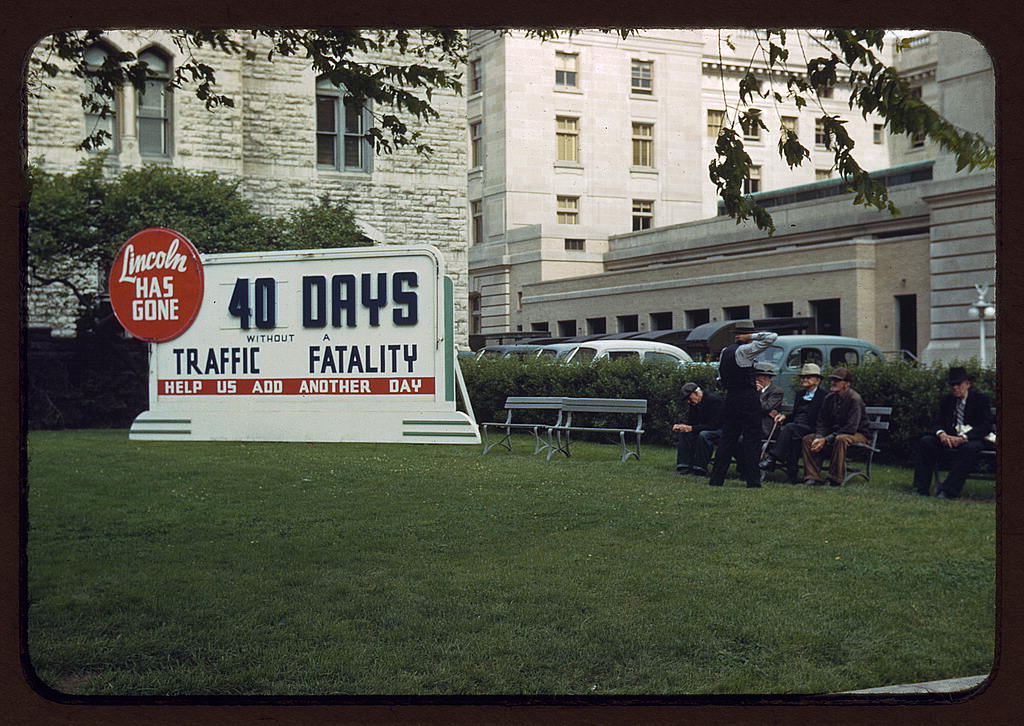
Lincoln, Nebraska: photo by John Vachon, 1942 (Farm Security Administration/Office of War Information Collection, Library of Congress)
It must have been in March the rug wore through.
Now the day passes and I stare
At warped pine boards my father's father nailed,
At the twisted grain. Exposed, where emptiness allows,
Are the wormholes of eighty years; four generations' shoes
Stumble and scrape and fall
To the floor my father stained,
The new blood streaming from his head. The drift
Of autumn fires and a century's cigars, that gun's
Magnanimous and brutal smoke, endure.
In March the rug was ragged as the past. Now it is August,
..And the floor is blank, worn smooth.
..And, for my life, imperishable.
Now the day passes and I stare
At warped pine boards my father's father nailed,
At the twisted grain. Exposed, where emptiness allows,
Are the wormholes of eighty years; four generations' shoes
Stumble and scrape and fall
To the floor my father stained,
The new blood streaming from his head. The drift
Of autumn fires and a century's cigars, that gun's
Magnanimous and brutal smoke, endure.
In March the rug was ragged as the past. Now it is August,
..And the floor is blank, worn smooth.
..And, for my life, imperishable.

Seed and feed store, Lincoln, Nebraska: photo by John Vachon, 1942 (Farm Security Administration/Office of War Information Collection, Library of Congress)
Photos by John Vachon (b. St. Paul, Minnesota, 14 May 1914; d. 20 April 1975, New York, New York) from Farm Security Administration/Office of War Information Collection, Library of Congress
Weldon Kees (b. 24 February 1915, Beatrice, Nebraska; d. 18 July 1955[?], San Francisco, California): The Upstairs Room, from Poems 1947-1954, 1954
Weldon Kees (b. 24 February 1915, Beatrice, Nebraska; d. 18 July 1955[?], San Francisco, California): The Upstairs Room, from Poems 1947-1954, 1954



7 comments:
Tom,
"Now the day passes and I stare. . ."
(Happy Birthday Johnny!)
2.15
first grey light in sky above blackness
of ridge, white half moon behind leaves
in foreground, wave sounding in channel
picture is described, three
objects in horizontal
state of waking, being self-
contained, incomplete
silver of low sun reflected in channel,
shadowed green pine on tip of sandspit
Oops, er... Happy Birthday, Johnny!
Weldon Kees, a bit of a mystery man in life and perhaps beyond.
picture is described, being incomplete
His car was found parked near the Golden Gate Bridge. It was assumed he had jumped off.
But then, in later years, people reported Weldon Kees sightings.
I once met one of these people.
All very Twilight Zone, but still.
Lincoln, Nebraska, by the way, is where Kees went to college and later went to work for the Federal Writer's Project.
John Vachon, who hailed from the same region of the country, first made his mark with the FSA on his Nebraska trips of the late 1930s.
I think Mystery Man is a good description. After an earlier posting I bought a Kees collection and mystery definitely applies to things I read there and the overall mood of this, which I like a great deal, both with and without the super Vachon photos.
Yes -- happy birthday Johny! It's my understanding that people can read this at least halfway across the universe.
Curtis
Curtis,
I love the idea of a smallish, compact E-Z Care Universe.
An upstairs bedroom in a frame house in a small town in Eastern Nebraska in the early stretches of the last century might well be its hub.
And the father, and the floorboards, and the fresh blood, perhaps observed by a child, and the smell of the cigars, recalled by an adult, and the ragged-edged rug, and the brutal, magnanimous smoke from the gun.
All that might be located at a point in spacetime or timespace precisely halfway across the whole arrangement, as seen from where we now sit.
Drifting out somewhere beyond all that, at the margins of the Great Void, the tiny dwindling figure of the poet might be rapidly vanishing from the radar.
His voice now barely audible, yet curiously imperishable.
Brutal/magnanimous; barely audible/curiously imperishable. Twilight Zone. All these fit into a world I understand and could live with. (I suppose for "brutal", I'd be willing to substitute "really, really forceful, unambiguous and definitive" to not offend or upset the fainter of heart.) You read the Kees poem and see the Vachon pictures and find yourself thinking "genius." I believe I've mentioned this before, but when I used to work for a division of Twentieth Century Fox, a job I really loved, one annoying thing about visiting the Los Angeles office (something I also enjoyed a lot; people were mostly very nice, the work was interesting and the weather was great) was that nothing was ever described as being less than "brilliant" and more "genius" superlatives were handed out than could possibly be deserved over 10 lifetimes. I mean, some of the studio's productions were quite good, but they didn't rate the excessive praise (and for the most part the dollars-and-cents executives, who all liked movies a lot, were pretty realistic about this.) The Kees poem and the Vachon pictures paired with it connect you up with something very grand, much finer and, really, a million times more accessible because of their clarity of expression. Curtis
Weldon departed for the great mystery almost 60 years ago—but first he left us some remarkable poems during the forty-some years he spent trying to come to terms with it— thanks for reminding us of that, Tom.
The formal quality I like most in Kees' poems is a kind of temporal circularity; they tend to come back round to where they started, suggesting history (including but not limited to the personal) both is, and is not, a one-way street.
This approximate rondel may be the piece that shows that feature to best advantage; anyhow it's long been one of my favourite poems:
1926
Post a Comment